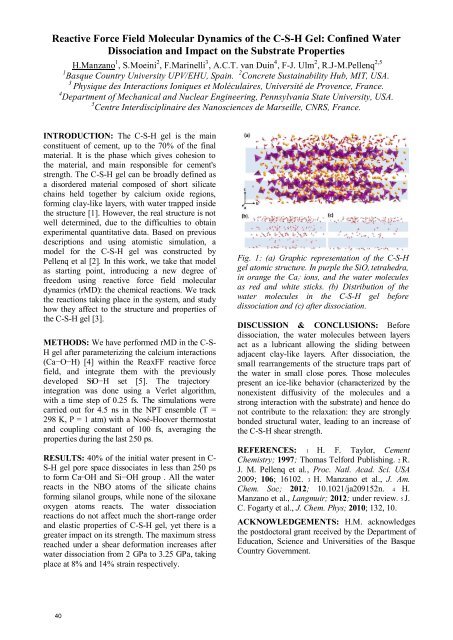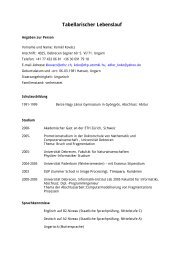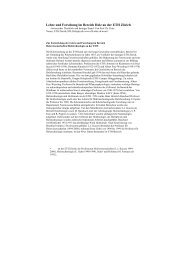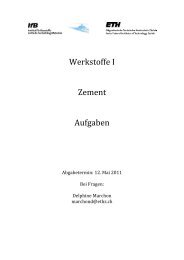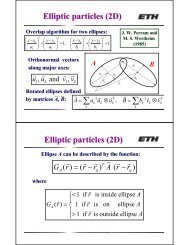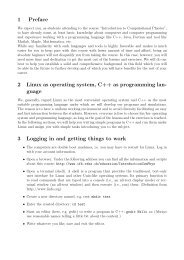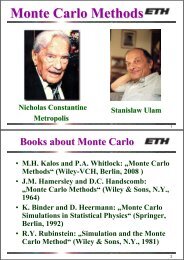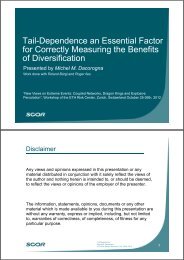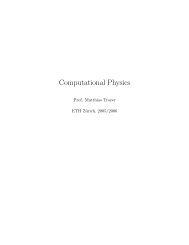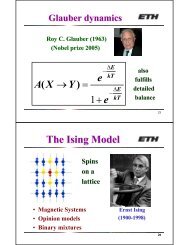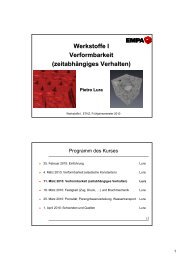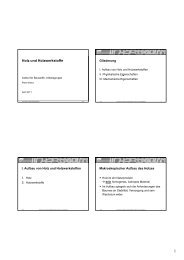Here - Institute for Building Materials - ETH Zürich
Here - Institute for Building Materials - ETH Zürich
Here - Institute for Building Materials - ETH Zürich
You also want an ePaper? Increase the reach of your titles
YUMPU automatically turns print PDFs into web optimized ePapers that Google loves.
Reactive Force Field Molecular Dynamics of the C-S-H Gel: Confined WaterDissociation and Impact on the Substrate PropertiesH.Manzano 1 , S.Moeini 2 , F.Marinelli 3 , A.C.T. van Duin 4 , F-J. Ulm 2 , R.J-M.Pellenq 2,51 Basque Country University UPV/EHU, Spain. 2 Concrete Sustainability Hub, MIT, USA.3Physique des Interactions Ioniques et Moléculaires, Université de Provence, France.4 Department of Mechanical and Nuclear Engineering, Pennsylvania State University, USA.5 Centre Interdisciplinaire des Nanosciences de Marseille, CNRS, France.INTRODUCTION: The C-S-H gel is the mainconstituent of cement, up to the 70% of the finalmaterial. It is the phase which gives cohesion tothe material, and main responsible <strong>for</strong> cement'sstrength. The C-S-H gel can be broadly defined asa disordered material composed of short silicatechains held together by calcium oxide regions,<strong>for</strong>ming clay-like layers, with water trapped insidethe structure [1]. However, the real structure is notwell determined, due to the difficulties to obtainexperimental quantitative data. Based on previousdescriptions and using atomistic simulation, amodel <strong>for</strong> the C-S-H gel was constructed byPellenq et al [2]. In this work, we take that modelas starting point, introducing a new degree offreedom using reactive <strong>for</strong>ce field moleculardynamics (rMD): the chemical reactions. We trackthe reactions taking place in the system, and studyhow they affect to the structure and properties ofthe C-S-H gel [3].M<strong>ETH</strong>ODS: We have per<strong>for</strong>med rMD in the C-S-H gel after parameterizing the calcium interactions(Ca−O−H) [4] within the ReaxFF reactive <strong>for</strong>cefield, and integrate them with the previouslydeveloped Si −O−H set [5]. The trajectoryintegration was done using a Verlet algorithm,with a time step of 0.25 fs. The simulations werecarried out <strong>for</strong> 4.5 ns in the NPT ensemble (T =298 K, P = 1 atm) with a Nosé-Hoover thermostatand coupling constant of 100 fs, averaging theproperties during the last 250 ps.RESULTS: 40% of the initial water present in C-S-H gel pore space dissociates in less than 250 psto <strong>for</strong>m Ca−OH and Si−OH group . All the waterreacts in the NBO atoms of the silicate chains<strong>for</strong>ming silanol groups, while none of the siloxaneoxygen atoms reacts. The water dissociationreactions do not affect much the short-range orderand elastic properties of C-S-H gel, yet there is agreater impact on its strength. The maximum stressreached under a shear de<strong>for</strong>mation increases afterwater dissociation from 2 GPa to 3.25 GPa, takingplace at 8% and 14% strain respectively.Fig. 1: (a) Graphic representation of the C-S-Hgel atomic structure. In purple the SiO 4 tetrahedra,+in orange the Ca 2 ions, and the water moleculesas red and white sticks. (b) Distribution of thewater molecules in the C-S-H gel be<strong>for</strong>edissociation and (c) after dissociation.DISCUSSION & CONCLUSIONS: Be<strong>for</strong>edissociation, the water molecules between layersact as a lubricant allowing the sliding betweenadjacent clay-like layers. After dissociation, thesmall rearrangements of the structure traps part ofthe water in small close pores. Those moleculespresent an ice-like behavior (characterized by thenonexistent diffusivity of the molecules and astrong interaction with the substrate) and hence donot contribute to the relaxation: they are stronglybonded structural water, leading to an increase ofthe C-S-H shear strength.REFERENCES: 1 H. F. Taylor, CementChemistry; 1997; Thomas Tel<strong>for</strong>d Publishing. 2 R.J. M. Pellenq et al., Proc. Natl. Acad. Sci. USA2009; 106; 16102. 3 H. Manzano et al., J. Am.Chem. Soc; 2012; 10.1021/ja209152n. 4 H.Manzano et al., Langmuir; 2012; under review. 5 J.C. Fogarty et al., J. Chem. Phys; 2010; 132, 10.ACKNOWLEDGEMENTS: H.M. acknowledgesthe postdoctoral grant received by the Department ofEducation, Science and Universities of the BasqueCountry Government.40


